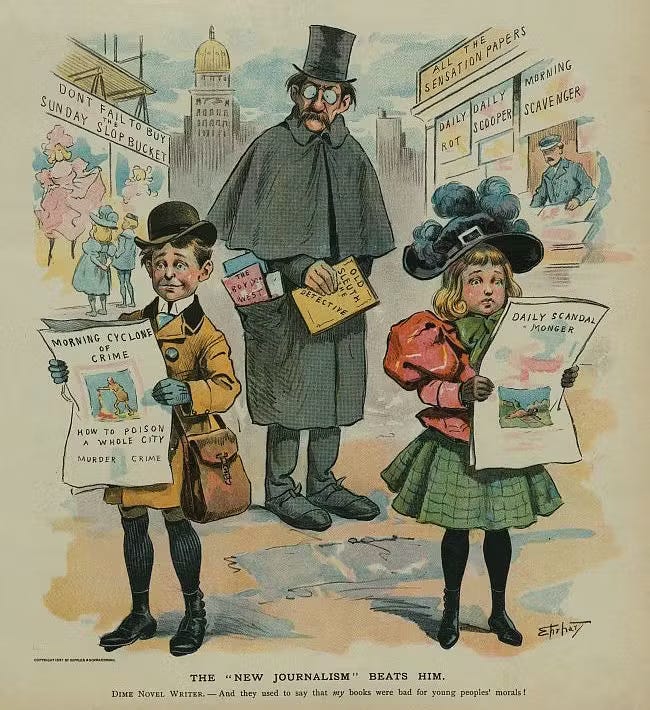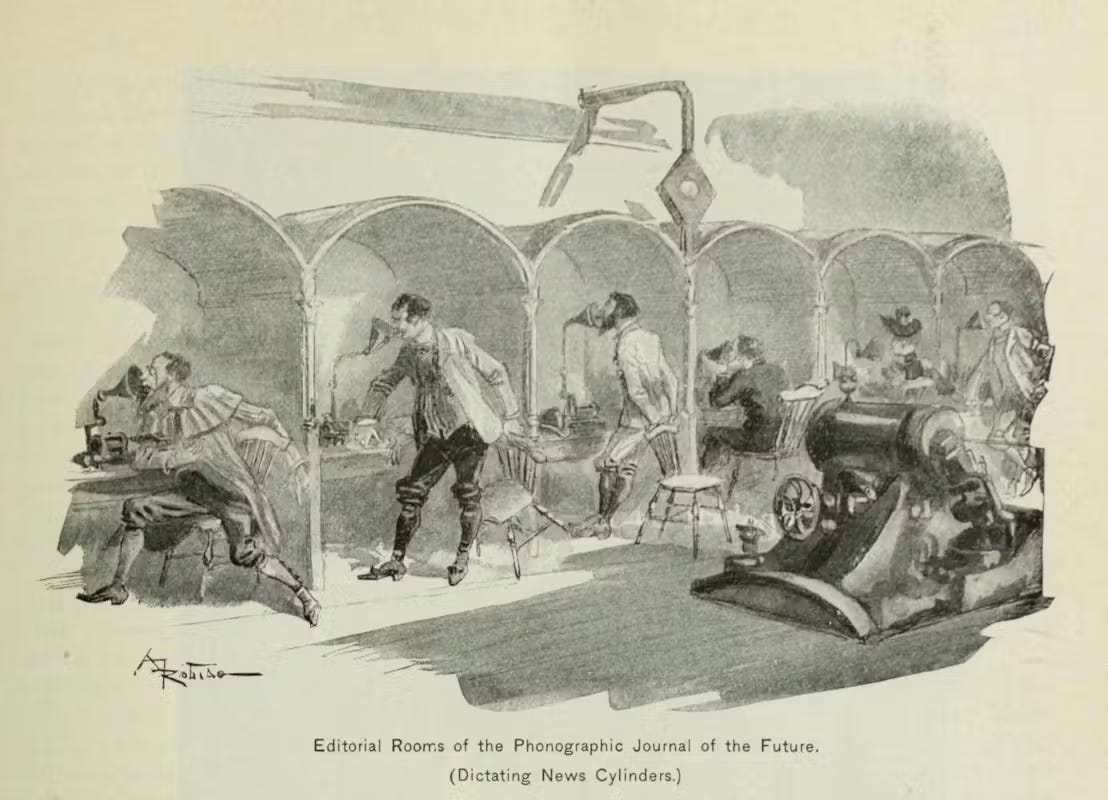The TikTok ban (and then unbanning) plowed into the internet information ecosystem like a hurricane, and Substack sought to capitalize on it like a seller of sandbags or toilet paper before a Category 4 storm.
There is nothing particularly unusual or wrong about this. Businesses see opportunities and go after them. This platform announced a “TikTok Liberation Prize” of $25,000 to be awarded to any creator who came up with a good viral trend or tactic for transferring their audience over to Substack. The winner of the prize was news influencer
Writing meta-commentaries on Substack about Substack is fundamentally tedious, but this one is important to me. Holding Aaron Parnas up as an example is a bad idea. It isn’t that his politics are particularly noxious — and even if they were, there’s an argument to be made that a platform like this should be an open public square. The problem is that Parnas posts slop, and the one bias this platform requires if we want it to be a useful, financially stable home for discourse and journalism is an anti-slop bias.
Maybe that’s not what the masters of Substack want it to be, but I hope that’s what you want it to be.
, , and the squad might just want “content” — and if you read the interview Best published with Parnas this week, it is all about “content” rather than substance. Since the pitches of both Substack and Parnas seem to profess an ideology — they’re crowing about how this is “the only platform not run by billionaires,” they’re giving Parnas a “Liberation prize,” etc. — this lack of substance reads as hypocrisy at worst and sloppiness at best.In my last post, I talked about how I hope internet communities can be an effective avenue for political organization. And I guess this post, while a deviation from my standard meme content (if I were a subscriber, I’d be annoyed at me over this) fits into that project. This post is an attempt to explore what holding content and communities to high standards might look like, and I have sought to make it as much a call-in as a call-out.

I. Why it is slop
Aaron Parnas is a news influencer who posts every hour or two on TikTok, essentially reading headlines and summarizing news stories in a minute or less. On most Parnas videos you see his gaze shift to something out-of-frame, where he seems to be reading the story he’s talking about from a media outlet he almost never cites. The videos always begin with “we have breaking news coming in,” and they are always about something that will scare you, which in today’s news environment is a lot of things, and which in today’s media environment are bound to get clicks.
Parnas posts minute-long updates “every hour, on the hour” and is now doing “long-form” five minute videos at the beginning and end of each day. It makes sense from a business perspective that Substack likes this kind of creator: Parnas produces a lot of content, constantly. He’s almost like a streamer or talk radio host: people can spend their whole days with him, on Substack, and he will post more than all the people who will make an essay a week. Creators who post a lot are not bad creators, and not every piece of media needs to be a voice-y longform essay, but choosing to aggressively incentivize quantity over quality feels like a shift from what users actually want Substack to be, and the unique value proposition it offers in a market saturated with cheap, short, and abundant slop.
Parnas is a news aggregator and not a reporter, as commenters on the perhaps overly-strident TikTok video I made about him said. A lot of people like him because he seems to offer reasonably comprehensive, unbiased, and accessible news which fits into their busy schedules. This is a noble task, but it’s not actually Parnas doing that: it’s the journalists whose work he’s reading from and not citing.
News does not fall out of a tree. It is gathered, often in a process that is difficult and even dangerous. As someone who aggregated news and internet culture for years and was paid for it, I know what Parnas is doing. Aggregation is often good and exposes more people to what’s happening in the world — but it has to be done in a way that it is sustainable. Even Drudge Report was full of hyperlinks.
If all the traffic and page views are going to middlemen like Parnas instead of the people who actually gather the news, then the people doing the news gathering won’t get paid and the news will stop being gathered. If that happens — and in today’s increasingly pauperized media environment, it’s a real risk — the only things you’ll have to aggregate are AI slop and political propaganda. This is gross, but it’s also unprofitable and will affect the bottom-line value of Substack as a business. If this platform fails to fund and offer actual news gathering or original analysis, people will leave.
Good aggregation also adds context, framing, and a touch of analysis. Now, there’s only so much you can do in a minute-long Instagram-monetizable video, but Parnas could at least use the seven seconds he always takes to plug himself on every other platform to instead inform viewers how whatever story he’s reading off the Associated Press website relates to what they heard yesterday, or might mean for their lives. He chooses not to, because growth seems to be more important than ideas.
I’d also argue the one-minute limit isn’t what keeps Parnas from citing sources. The lack of citation is because he has to paint himself as an alternative to “legacy media,” and if he were to actually say “this is from Politico,” then that whole shtick wouldn’t work. From his “Reintroducing Myself” post on Substack:
Since November 5th, I have gained more than two million new followers across my social media platforms, with the most on TikTok. I don’t write that to brag. I write that because Americans are waking up to a new landscape following this election. Legacy media is no longer dying. It’s dead. And, it died on November 5th.
During the 2024 election, we saw legacy media channels fail everyday Americans time and time again…
I agree with Parnas on this. But, my brother in Christ, your content is legacy media content. He is literally just reading legacy media reporting into his phone camera and the information he gives you is the exact same as you would get if you read any mainstream outlet. Parnas is offering no alternative, and neither is Substack if this creator is the template for everyone. If the idea is to not repeat legacy media’s mistakes in alt media, then here are two big ones Parnas consistently repeats, along with the literal reporting he reads:
Parnas’ supposedly-comprehensive reporting is full of selective blindspots. Anything about Gaza, the humanity of Palestinians, or the obvious criminality of Israel’s leaders is not included in “the Parnas Perspective.” He also doesn’t seem to cover corruption much. These lies by omission feel intentional, and are the exact same issues that people have with legacy media.
Every Parnas video is “breaking news.” His best performing ones are the scariest ones. There is an attachment between Parnas and his audience which reminds me of the CNN, MSNBC, or even Fox addiction that people fall into. It is a kind of trauma-bond. When you get really into watching this sort of media, you get scared (reasonably so) and you get sad. And you start to feel a bond to the person who shares the painful information with you. This attachment arises from the mismatch between form and content: what Parnas talks about makes people panic, but his presentation is reassuringly calm and steady. He incites the bad emotion and then he soothes it, so you credit him with giving you the relief. This, again, is exactly the problem people say they have with legacy media.
Combine with these flaws the lack of accountability and supervision that comes with his “full editorial control,” and you have something that may prove to be worse than the legacy media.

So far, I have stuck to substantive critiques of Parnas’ work. But it’s worthwhile to talk about his background — one generally agreed-upon flaw of legacy media is its revolving door nature, where former politicos and insiders can fail up into cushy gigs where they get treated as experts. Parnas, who in another life “met Donald Trump on several occasions,” “listened in on calls with Bill Barr and Nicolas Maduro,” “and spent two days in a hotel room strategizing with Rudy Giuliani, exports this dynamic to new media.
His father is Lev Parnas, Rudy Giuliani’s fixer who was sent out to Ukraine in order to dig up dirt on Hunter Biden. Lev, who committed multiple crimes on Donald Trump’s behalf, was then thrown under the bus, convicted of felonies, and sent to jail. Aaron has kind of addressed these events in “storytimes,” here are his words:
I have had the most interesting seven years probably of any person. So here’s a storytime. I started college when I was 14 years old. I graduated college when I was 18 years old. I started law school at GW Law when I was 18 years old. And at the same time — you may know who my dad is, his name is Lev Parnas, he was deeply involved with Donald Trump, Rudy Giuliani, and the first Trump administration. Yes, Lev Parnas, the central figure of the first impeachment hearings regarding Ukraine and Donald Trump. I had no part in that. But being his son, I sat in a number of meetings, whether it was calls to Attorney General Bill Barr, whether it was listening to Rudy talk about the response to the Mueller report. I was doing that when I was eighteen years old, one of the youngest law students in the country. I graduated law school when I was 21, during the pandemic casually, I clerked for a federal judge, worked for small and big law firms. Then I decided to open up a TikTok account…
First of all, Donald Trump was clearly “the central figure of the first Trump impeachment.” Second, it seems the main thing Aaron Parnas learned from what happened with his dad is that he and his family are special. That’s also the main thing he seems to have learned while at law school. There is more name-dropping here than self-reflection — yet another agreed-upon issue with legacy media.
The sins of the father shouldn’t define the son — but in this instance, the sins of the father warrant a healthy skepticism towards the son, particularly if the son says he is a journalist reporting on the same political system which his father worked assiduously to corrupt and undermine.
Maybe I’m being too mean here. Aaron Parnas is about my age and I admire the man’s hustle. What set him apart and made him so successful on TikTok was the grind of posting every hour, obsessively covering each news headline. His delivery is good and his summaries are articulate. Commenters on his videos keep reminding Parnas to drink water, sleep, and do self-care — I think they’re picking up on something real: the man is exhausted from his hard work. I feel empathy for that. Aren’t we all exhausted?
II. The issue with “content”
The measure of whether a post on the internet is good is not the number which gets attached to the bottom of it. In a spiritual sense, this was always true, but in a practical sense it’s now also true. We live in the time of dead internet and enshittified platforms. What does well on the algorithms is what the algorithms like, not what people actually like or need. A like count or a follower count is a less meaningful gauge of quality or relevance than it has ever been.
I was pushed to write this post by seeing the comments on my video about Parnas. He has tons of fans who will relentlessly defend him, accuse me of being a rightwing agent sent to discredit him, argue that I’m just jealous (I am jealous of the $25,000 he got from Substack, that’s actually true) and that I must have voted for Trump. They say Parnas is the only one giving them the truth, Parnas works harder than anyone, Parnas offers the news with “no fluff” and “no bias.”
This is not the parasocial role which a journalist should play, but there’s a reason why people want someone like Parnas, and why they feel so strongly about him. We are all deeply afraid right now. He has given some people a kind of relief, or at least stability as they doomscroll and his little updates keep popping up in their feeds. This relief is what all news outlets sell, as much as they sell information, and we don’t usually see them that way — but maybe we should. And then we should ask them to sell a surer, more honest, and less manipulative form of relief, just as we ask them to print high-quality and clearly-stated information.
One criticism I received was that by being a Parnas opp, I’m participating in a left-wing tradition of attacking people who are otherwise doing good work. I see some validity in this argument, but want to point out two things: first, my issue with Parnas is not primarily his political purity but the form and delivery of his content; second, the embrace of Parnas by Substack and a sudden influx of fans post-election means he’s at a point where he should be questioned. We can and should be holding people like him to a higher standard, since he is a pioneer of a new form of journalism — and a competitive advantage of alt media is the audience’s increased ability to hold people to that higher standard.
Substack should also be questioned too —
is actually the most interesting and relevant actor here. Does this platform care about free speech or does it care about the numbers that attach themselves to speech, about the viewers, shares, and dollars? If you agree with the “Substack should be politically neutral” thing, these latest actions must make you wonder: is it actual political neutrality, or is it a business calculation to not miss out on any segment of the market?If it is a business calculation, it’s a bad one. Substack has the capacity to make something more valuable and sustainable. This platform can incentivize substance and ideas rather than “content” like the rest of the internet does. In an age where, as Aaron Parnas rightly says, “legacy media is no longer dying. It’s dead,” we need a new media that actually works and can help preserve our liberties and free thought. If the people running Substack can’t or don’t want to do that, then you can — because ultimately platforms don’t belong to the companies who build them, they belong to the people who post on them. Substack needs you more than you need it, and that’s especially true if you’re a reader rather than a writer on here.
So let’s not be sloppy.




Very strange but in keeping with the times.
That SS ignores the obvious—that this guy is stealing other people’s hard work without attribution—is depressing.
It also highlights how distorted the overall atmosphere has become online amidst ongoing enshitification—murky and semi-criminal—but that’s OK because: CONTENT!!!!!!!!!!!!!!!!
I hate it. lol.
loved the points you made. so thoughtful & well-written! thank u for sharing your perspective